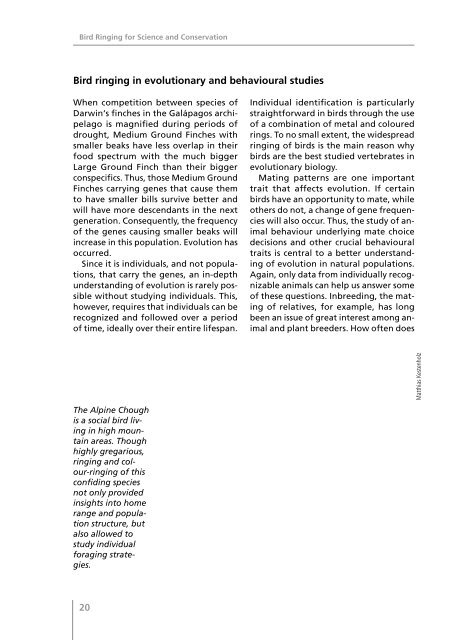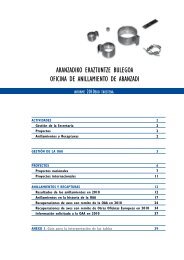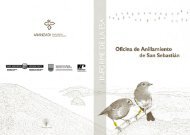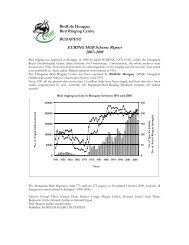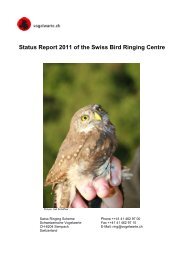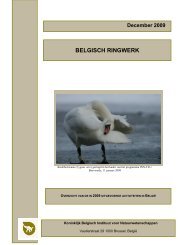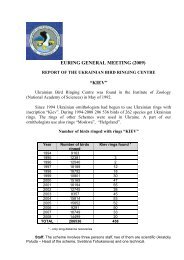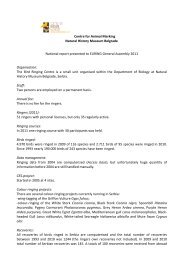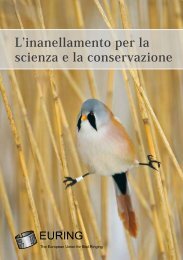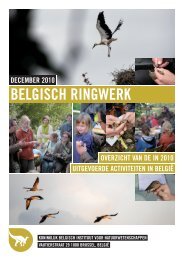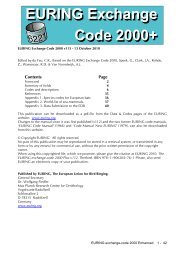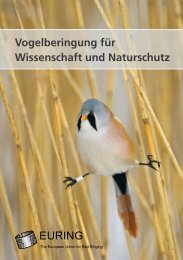Bird Ringing for Science and Conservation - The European Union ...
Bird Ringing for Science and Conservation - The European Union ...
Bird Ringing for Science and Conservation - The European Union ...
- No tags were found...
Create successful ePaper yourself
Turn your PDF publications into a flip-book with our unique Google optimized e-Paper software.
<strong>Bird</strong> <strong>Ringing</strong> <strong>for</strong> <strong>Science</strong> <strong>and</strong> <strong>Conservation</strong><br />
<strong>Bird</strong> <strong>Ringing</strong> <strong>for</strong> <strong>Science</strong> <strong>and</strong> <strong>Conservation</strong><br />
<strong>Bird</strong> ringing in evolutionary <strong>and</strong> behavioural studies<br />
When competition between species of<br />
Darwin‘s finches in the Galápagos archipelago<br />
is magnified during periods of<br />
drought, Medium Ground Finches with<br />
smaller beaks have less overlap in their<br />
food spectrum with the much bigger<br />
Large Ground Finch than their bigger<br />
conspecifics. Thus, those Medium Ground<br />
Finches carrying genes that cause them<br />
to have smaller bills survive better <strong>and</strong><br />
will have more descendants in the next<br />
generation. Consequently, the frequency<br />
of the genes causing smaller beaks will<br />
increase in this population. Evolution has<br />
occurred.<br />
Since it is individuals, <strong>and</strong> not populations,<br />
that carry the genes, an in-depth<br />
underst<strong>and</strong>ing of evolution is rarely possible<br />
without studying individuals. This,<br />
however, requires that individuals can be<br />
recognized <strong>and</strong> followed over a period<br />
of time, ideally over their entire lifespan.<br />
<strong>The</strong> Alpine Chough<br />
is a social bird living<br />
in high mountain<br />
areas. Though<br />
highly gregarious,<br />
ringing <strong>and</strong> colour-ringing<br />
of this<br />
confiding species<br />
not only provided<br />
insights into home<br />
range <strong>and</strong> population<br />
structure, but<br />
also allowed to<br />
study individual<br />
<strong>for</strong>aging strategies.<br />
Individual identification is particularly<br />
straight<strong>for</strong>ward in birds through the use<br />
of a combination of metal <strong>and</strong> coloured<br />
rings. To no small extent, the widespread<br />
ringing of birds is the main reason why<br />
birds are the best studied vertebrates in<br />
evolutionary biology.<br />
Mating patterns are one important<br />
trait that affects evolution. If certain<br />
birds have an opportunity to mate, while<br />
others do not, a change of gene frequencies<br />
will also occur. Thus, the study of animal<br />
behaviour underlying mate choice<br />
decisions <strong>and</strong> other crucial behavioural<br />
traits is central to a better underst<strong>and</strong>ing<br />
of evolution in natural populations.<br />
Again, only data from individually recognizable<br />
animals can help us answer some<br />
of these questions. Inbreeding, the mating<br />
of relatives, <strong>for</strong> example, has long<br />
been an issue of great interest among animal<br />
<strong>and</strong> plant breeders. How often does<br />
Matthias Kestenholz<br />
<strong>The</strong> Dipper. Colour<br />
ringing has<br />
shown that this<br />
attractive species<br />
can sometimes be<br />
infanticidal <strong>and</strong><br />
incestuous.<br />
Johann Hegelbach<br />
inbreeding occur in the wild <strong>and</strong> what<br />
are its consequences When birds of one<br />
population are individually colour-ringed<br />
<strong>for</strong> many years, we can construct pedigrees<br />
that allow us to infer the degree of<br />
inbreeding <strong>and</strong> thus its causes <strong>and</strong> consequences.<br />
On a small isl<strong>and</strong> in Canada,<br />
<strong>for</strong> example, Song Sparrows have been<br />
shown to mate with a relative as often<br />
as expected by chance. Thus, Song Sparrows<br />
do not seem to avoid mating with<br />
relatives, despite the fact that inbreeding<br />
considerably reduces reproductive<br />
success <strong>and</strong> survival.<br />
In a population of <strong>European</strong> Dippers in<br />
Switzerl<strong>and</strong>, one female paired up with<br />
her son which himself had originated<br />
from a pairing between her <strong>and</strong> her<br />
brother. On the other h<strong>and</strong>, one male of<br />
these Cinclus c. aquaticus was resighted<br />
in Pol<strong>and</strong>, mated to a dipper that had<br />
been ringed in Sweden as a C. c.cinclus.<br />
It is difficult to conceive of more opposite<br />
mating patterns among individual<br />
birds from the same population.<br />
Some of the most interesting behaviours<br />
are those that appear at first to contradict<br />
simple evolutionary explanations.<br />
One such behaviour is infanticide which<br />
has been described in a small number of<br />
bird species including the <strong>European</strong> Dipper.<br />
Why would male Dippers kill young<br />
in nests of other pairs in the population<br />
when they do not seem to have anything<br />
to do with that nest At first sight, one is<br />
tempted to explain such occurrences as<br />
aberrant behaviours. However, an alternative,<br />
evolutionary explanation is that<br />
the infanticidal males are killing the<br />
young so that the females will lay a new<br />
clutch which could be fathered by the infanticidal<br />
male. Observations of individually<br />
colour-ringed birds combined with<br />
genetic analyses have the potential to<br />
resolve this <strong>and</strong> many other fascinating<br />
questions in modern biology.<br />
20<br />
21


